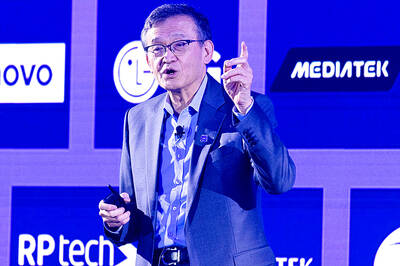Container shipper Wan Hai Lines Ltd (萬海航運) yesterday said it is looking to Vietnam for growth potential, as the US-China trade dispute casts a cloud over the shipping industry.
“We cannot be too optimistic about our profit growth this year, as it is difficult to forecast demand for freight transport in light of the uncertainty arising from the trade war,” Wan Hai president Tommy Hsieh (謝福隆) told reporters on the sidelines of a shareholders’ conference in Taipei.
With US President Donald Trump and Chinese President Xi Jinping (習近平) likely to meet at the G20 summit in Japan at the end of this month, the situation might unravel, Hsieh said.
While some of the shipper’s peers earlier this year said that the trade tension might boost freight volume for the intra-Asia region, he disagreed, saying that the volume has stayed flat from a year earlier.
“As most Asian countries are manufacturing countries, they need to export their goods to end markets outside Asia. It is not easy for them to find new markets or change their supply chain so soon,” Hsieh said.
Most of Wan Hai’s clients still demand the shipper to operate on the same routes, he added.
However, the company’s Vietnam freight volume has risen more than other countries, as Vietnam, ranked second among all Asian countries in exports to the US last year, has seen its exports to the US jump this year, he said.
“Vietnam is the country most shipping companies are paying attention to, but we have our competitive strengths, as we have been operating some routes to this nation for a long time,” Wan Hai spokeswoman Laura Su (蘇麗梅) said.
Backed by client demand, Wan Hai in April started operating two direct routes from Vietnam to western US, with one from Haiphong and the other from Ho Chi Minh, Su said, adding that both lines have reduced transportation time to the US.
Wan Hai earlier this year invested in a port in Da Nang in central Vietnam, which should be helpful to its business there, Hsieh said.
Overall, this year could be better than last year if the trade tension eases and crude oil prices remain stable, he said.
Shareholders approved a proposal to distribute a cash dividend of NT$0.6 per common share, representing a payout ratio of 120 percent based on the company’s earnings per share of NT$0.5 for last year.
Wan Hai plans to issue NT$4.8 billion of unsecured corporate bonds in two tranches via an auction this month to fund its purchase of 20 container vessels and repay bank loans, the company said.
The company plans to sell NT$1.5 billion in three-year bonds and NT$3.3 billion in five-year bonds, with coupon rates of 0.95 percent and 1.05 percent respectively, it said in a filing with the Taiwan Stock Exchange.

The Eurovision Song Contest has seen a surge in punter interest at the bookmakers, becoming a major betting event, experts said ahead of last night’s giant glamfest in Basel. “Eurovision has quietly become one of the biggest betting events of the year,” said Tomi Huttunen, senior manager of the Online Computer Finland (OCS) betting and casino platform. Betting sites have long been used to gauge which way voters might be leaning ahead of the world’s biggest televised live music event. However, bookmakers highlight a huge increase in engagement in recent years — and this year in particular. “We’ve already passed 2023’s total activity and

Nvidia Corp CEO Jensen Huang (黃仁勳) today announced that his company has selected "Beitou Shilin" in Taipei for its new Taiwan office, called Nvidia Constellation, putting an end to months of speculation. Industry sources have said that the tech giant has been eyeing the Beitou Shilin Science Park as the site of its new overseas headquarters, and speculated that the new headquarters would be built on two plots of land designated as "T17" and "T18," which span 3.89 hectares in the park. "I think it's time for us to reveal one of the largest products we've ever built," Huang said near the

China yesterday announced anti-dumping duties as high as 74.9 percent on imports of polyoxymethylene (POM) copolymers, a type of engineering plastic, from Taiwan, the US, the EU and Japan. The Chinese Ministry of Commerce’s findings conclude a probe launched in May last year, shortly after the US sharply increased tariffs on Chinese electric vehicles, computer chips and other imports. POM copolymers can partially replace metals such as copper and zinc, and have various applications, including in auto parts, electronics and medical equipment, the Chinese ministry has said. In January, it said initial investigations had determined that dumping was taking place, and implemented preliminary

Intel Corp yesterday reinforced its determination to strengthen its partnerships with Taiwan’s ecosystem partners including original-electronic-manufacturing (OEM) companies such as Hon Hai Precision Industry Co (鴻海精密) and chipmaker United Microelectronics Corp (UMC, 聯電). “Tonight marks a new beginning. We renew our new partnership with Taiwan ecosystem,” Intel new chief executive officer Tan Lip-bu (陳立武) said at a dinner with representatives from the company’s local partners, celebrating the 40th anniversary of the US chip giant’s presence in Taiwan. Tan took the reins at Intel six weeks ago aiming to reform the chipmaker and revive its past glory. This is the first time Tan